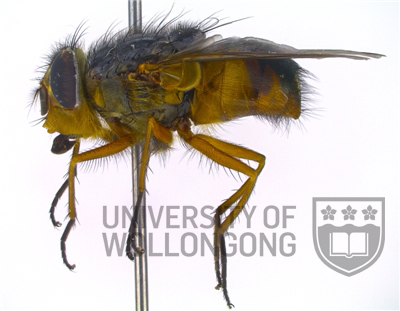Taxonomy
Family: Calliphoridae
Subfamily: Calliphorinae
Genus: Calliphora Robineau-Desvoidy 1830
Subgenus: Paracalliphora Townsend 1916
Species: augur (Fabricius 1775)
The first- and second-instar larvae were described by O'Flynn and Moorhouse (1983) and the third-instar larva by Wallman (2001). Erzinçlioglu (1984) described all three larval instars of this species.
Biology
Calliphora augur is a common blowfly in south-eastern Australia, where it is agriculturally and forensically important. It is the sister species to the western analogue, Calliphora dubia. Typically, this species will visit a carcass early in the decomposition process and it has been recorded as a myiasis fly of sheep (Watts et al., 1976).
Calliphora augur is ovoviviparous, laying approximately fifty larvae sheathed in a chorion (egg shell) which hatch almost instantaneously (Norris 1959). There are also reports in the literature that this species is facultatively oviparous (Johnston and Tiegs 1922, Meier et al. 1999). Larval developmental data have been obtained for C. augur by Day (2006), Day and Wallman (2006) and O'Flynn (1983). It is perhaps the most forensically important fly in New South Wales, where it was utilised in over 30% of cases between 1984 and 2001 (Levot 2003), and consequently larval development of this species is quite well understood (Day 2006; O'Flynn 1983).
Calliphora augur is morphologically similar to C. dubia, with yellow pruinescence on the 5th abdominal tergite, whereas there is vivid white pruinescence in C. dubia. Male C. augur can be readily distinguished by the minimum frons width being less than twice the width of the anterior ocellus, whereas in male C. dubia the minimum frons width is twice the width of the anterior ocellus (see picture). To determine the gender of your fly click here.
Distribution
Calliphora augur is common throughout south-eastern Australia, being found in the Australian Capital Territory, New South Wales, Queensland, South Australia, Tasmania and Victoria. It occurs sympatrically with Calliphora dubia throughout eastern South Australia, Kangaroo Island and western New South Wales and Victoria (Wallman & Adams 1997).
It is generally absent during winter, becoming most abundant during early to mid-summer. It may experience a population decline during summer in the northern areas of its distribution (Johnson 2007).
Relevant Literature
Archer, M.S. and Elgar, M.A.
(2003) Yearly activity patterns in southern Victoria
(Australia) of seasonally active carrion
insects. Forensic
Science International 132, 173-176.
Callinan, A.P.L. (1980) Aspects
of the ecology of Calliphora augur
(Fabricus) (Diptera:
Calliphoridae), a native Australian blowfly.
Australian Journal of Zoology 28,
679-684.
Day, D.M. (2006) Development of
immature blowflies and their application to
forensic science. MSc Thesis,
University of Wollongong.
Day, D.M. and Wallman, J.F.
(2006). Influence of substrate tissue type on
larval growth in Calliphora augur and Lucilia cuprina
(Diptera:
Calliphoridae). Journal of Forensic Sciences 51,
657-663.
Erzinclioglu, Y.Z. 1984. Studies on the morphology and taxonomy of
the immature stages of Calliphoridae, with
analysis of phylogenetic relationships within the
family, and between it and other groups in the
Cyclorrhapha (Diptera). Ph.D., University of
Durham.
Fuller, M.E. (1934) The insect
inhabitants of carrion: a study
in animal ecology. Council for Scientific and Industrial
Research, Australia, Bulletin 82, 1-63.
Johnson, A.P. (2007) Climatic and
biotic influences on the distributions of Calliphora
augur and Calliphora
dubia (Diptera:
Calliphoridae). B. Sc. Honours,
University of Wollongong.
Johnston, T.H. and
Tiegs, O.W. (1922) Notes on the Biology of some of
the More Common Queensland Muscoid Flies. Proceedings
of the Royal Society of Queensland 77-104.
Lee, D.J. (1968) Human myiasis
in Australia. The Medical Journal of Australia
170-172.
Levot, G.W. (2003) Insect fauna used to estimate the post-mortem interval of deceased persons. General and Applied Entomology 32, 31-39.
Meier, R., Kotrba, M. and
Ferrar, P. (1999) Ovoviviparity
and viviparity in the Diptera. Biological
Reviews 74,
199-258.
Norris, K.R. (1959) The
ecology of sheep blowflies in Australia. In:
Keast, A., Crocker, R.L. and Christian, C.S.
(eds.) Biogeography
and Ecology in Australia. DW. Junk,
Netherlands.
O'Flynn, M.A. (1983). The
succession and rate of development of blowflies
in southern Queensland and the application of
these data to forensic entomology. Journal of
the Australian Entomological Society 22,
137-148.
O'Flynn, M.A. and Moorhouse,
D.E. (1980) Identification of early immature
stages of some common Queensland carrion flies.
Journal of the Australian Entomological
Society 19, 53-61.
Wallman, J.F. (2001) Third-instar larvae
of common carrion-breeding
blowflies of the genus Calliphora
(Diptera:
Calliphoridae) in South Australia. Invertebrate
Taxonomy 15, 37-51.
Wallman, J.F. and Adams, M.
(1997) Molecular systematics of Australian carrion-breeding
blowflies of the genus Calliphora
(Diptera:
Calliphoridae). Australian
Journal of Zoology 45,
337-356.
Watts, J.E., Muller, M.J., Dyce, A.L. and Norris, K.R. (1976) The species of flies reared from struck sheep in south-eastern Australia. Australian Veterinary Journal 52, 488-489.



